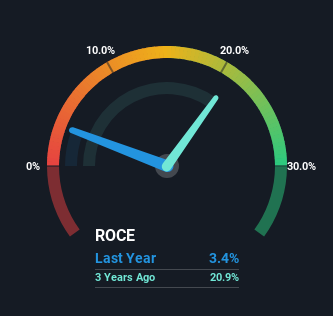- South Korea
- /
- Luxury
- /
- KOSDAQ:A306040
Investors Could Be Concerned With SJ Group's (KOSDAQ:306040) Returns On Capital
What trends should we look for it we want to identify stocks that can multiply in value over the long term? Typically, we'll want to notice a trend of growing return on capital employed (ROCE) and alongside that, an expanding base of capital employed. This shows us that it's a compounding machine, able to continually reinvest its earnings back into the business and generate higher returns. However, after investigating SJ Group (KOSDAQ:306040), we don't think it's current trends fit the mold of a multi-bagger.
Understanding Return On Capital Employed (ROCE)
Just to clarify if you're unsure, ROCE is a metric for evaluating how much pre-tax income (in percentage terms) a company earns on the capital invested in its business. To calculate this metric for SJ Group, this is the formula:
Return on Capital Employed = Earnings Before Interest and Tax (EBIT) ÷ (Total Assets - Current Liabilities)
0.034 = ₩5.9b ÷ (₩214b - ₩41b) (Based on the trailing twelve months to June 2024).
Thus, SJ Group has an ROCE of 3.4%. Ultimately, that's a low return and it under-performs the Luxury industry average of 7.3%.
Check out our latest analysis for SJ Group

Historical performance is a great place to start when researching a stock so above you can see the gauge for SJ Group's ROCE against it's prior returns. If you'd like to look at how SJ Group has performed in the past in other metrics, you can view this free graph of SJ Group's past earnings, revenue and cash flow.
What Can We Tell From SJ Group's ROCE Trend?
On the surface, the trend of ROCE at SJ Group doesn't inspire confidence. Around five years ago the returns on capital were 32%, but since then they've fallen to 3.4%. On the other hand, the company has been employing more capital without a corresponding improvement in sales in the last year, which could suggest these investments are longer term plays. It's worth keeping an eye on the company's earnings from here on to see if these investments do end up contributing to the bottom line.
On a side note, SJ Group has done well to pay down its current liabilities to 19% of total assets. That could partly explain why the ROCE has dropped. Effectively this means their suppliers or short-term creditors are funding less of the business, which reduces some elements of risk. Since the business is basically funding more of its operations with it's own money, you could argue this has made the business less efficient at generating ROCE.
The Key Takeaway
To conclude, we've found that SJ Group is reinvesting in the business, but returns have been falling. Moreover, since the stock has crumbled 72% over the last three years, it appears investors are expecting the worst. All in all, the inherent trends aren't typical of multi-baggers, so if that's what you're after, we think you might have more luck elsewhere.
If you want to continue researching SJ Group, you might be interested to know about the 3 warning signs that our analysis has discovered.
While SJ Group isn't earning the highest return, check out this free list of companies that are earning high returns on equity with solid balance sheets.
New: Manage All Your Stock Portfolios in One Place
We've created the ultimate portfolio companion for stock investors, and it's free.
• Connect an unlimited number of Portfolios and see your total in one currency
• Be alerted to new Warning Signs or Risks via email or mobile
• Track the Fair Value of your stocks
Have feedback on this article? Concerned about the content? Get in touch with us directly. Alternatively, email editorial-team (at) simplywallst.com.
This article by Simply Wall St is general in nature. We provide commentary based on historical data and analyst forecasts only using an unbiased methodology and our articles are not intended to be financial advice. It does not constitute a recommendation to buy or sell any stock, and does not take account of your objectives, or your financial situation. We aim to bring you long-term focused analysis driven by fundamental data. Note that our analysis may not factor in the latest price-sensitive company announcements or qualitative material. Simply Wall St has no position in any stocks mentioned.
About KOSDAQ:A306040
SJ Group
Manufactures and sells backpacks, hats, children's clothing, innerwear, and women's wear.
Mediocre balance sheet with low risk.
Market Insights
Community Narratives



